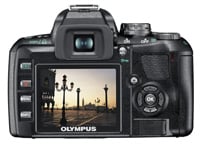Olympus E-410
-
-
Written by Gordon Laing
Olympus E-410 verdict
The Olympus E-410 may only be a subtly upgraded version of its predecessor, but since the E-400 had limited availability (and could possibly soon be discontinued), it’s worth addressing the E-410 as a completely new camera.
First things first: the E-410 is a seriously small DSLR. Indeed by inheriting its predecessor’s body, it shares the honour of being the world’s smallest and lightest DSLR. Crucially though, the retro design allows it to remain comfortable to hold and use despite its compact dimensions.
It may be small, light and styled like an SLR of the 80s, but Olympus has packed the E-410 with the latest technology. The Live View facility may be clunky at times and not as smooth as a consumer compact, but we found it invaluable on several occasions, whether delivering 100% coverage, overlaid guidelines or a depth-of-field preview. Live View also makes the E-410 one of the easiest DSLRs to work with underwater using the optional PT-E03 housing – and this is a key advantage it has over the forthcoming E-510 which currently has no underwater housing.
 |
The E-410’s also inherited a neat control system which allows you to quickly and easily adjust a wide variety of settings, without having to dedicate buttons to things like ISO or white balance. And while the legendary SSWF anti-dust filter may not be totally infallible, it continues to do a better job than its rivals at either eliminating dust or at least making it tough to spot on your photos.
The new kit lenses, redesigned for the E-400, are also a triumph of budget optics. The Zuiko Digital 14-42mm ED may be significantly smaller and lighter than the older 14-45mm kit lens, but it out-performs it in many respects. We noticed out-of-focus bokeh effects with this lens which could displease some photographers (see our earlier Olympus E-400 Gallery), but it remains superior overall to most kit lenses and even boasts internal focusing and a supplied lens hood.
It sure sounds like a great package so far, but there are of course a number of downsides. First the small body may not be to everyone’s tastes. While there’s no finger-pinching to worry about between the non-existent grip and lens barrel, the E-410 may still be too small for some to hold comfortably. Then there’s the foibles of the Four Thirds system itself: the basic three-point AF system of all models to date, the motor-assisted manual focusing and the viewfinder, while a great improvement on some earlier Olympus models, remains smaller than most DSLRs.
Perhaps the E-410’s worst aspect though is its lack of anti-shake options. There may be over 30 lenses available for the Four Thirds fit, but only one has image stabilisation and it ain’t cheap, nor widely available. Panasonic and Leica, the manufacturers of this 14-50mm lens, have promised another with a compelling 28-300mm equivalent range, but its due date and price remain unknown. Olympus, committed as it is to sensor-shift anti-shake, is unlikely to produce any stabilised optics, and Sigma’s only stabilised lens is currently for Canon, Nikon and Sigma fits only.
So if anti-shake facilities are important to you right now, the E-410 is probably not the camera for you. Indeed it rather highlights how tempting the forthcoming E-510 model is instead with built-in sensor-shift stabilisation. And speaking of other models, here’s how the E-410 measures-up against its rivals.
Compared to Olympus E-400
The European-only E-400 is of course the E-410’s closest rival – after all, they’re identical other than their sensors. So the E-410 clearly has the edge with its Live View facility, but that’s not to say you should disregard the older model from your shopping list.
It’s currently unknown what will happen to the E-400, but judging by the clearance pricing of many retailers, we’d suspect it’s not long for the shelves. As such you can currently pick up an E-400 at a low, low price. Sure it may not have Live View, but it’s still an excellent 10 Megapixel DSLR which shares the honour of being the world’s smallest and lightest. If the price is right, you could bag yourself a bargain. Do watch out for lens kits though as some particularly good deals may come with an older model. See our Olympus E-400 review for more details.
Compared to Canon EOS-400D / XTi
Canon’s EOS 400D / Rebel XTi is likely to be the E-410’s biggest rival and the two have a lot in common: 10 Megapixel resolution, 2.5in screen, anti-dust facilities and compact dimensions. In the E-410’s favour, it’s smaller and lighter still, comes with a superior kit lens and its anti-dust filter proved much more effective in our tests. It’s also got the unique Live View facility. In the Canon’s favour though, it boasts a far more sophisticated 9-point auto-focus system, a wider viewfinder, and crucially while the kit lens may not be great, there are at least a wide variety of stabilised models to upgrade to. Bulk buying and heavy discounting could also see the Canon available cheaper. Check out our Canon EOS 400D / Rebel XTi review. |
Compared to Nikon D40x
Nikon’s D40x is another 10 Megapixel DSLR with a 2.5in screen, but it takes a slightly different approach to photography. Its big selling point is the ease with which DSLR beginners can get to grips with it. The D40x, like the D40, is arguably the friendliest DSLR to date while boasting Nikon’s legendary metering system which simply out-performs all rivals. The kit lens is also pretty good, and like Canon, there’s several stabilised options if you want to upgrade to anti-shake. On the downside, the D40x doesn’t have Live View, any active anti-dust technology, and it too only has a basic 3-point AF system. The user interface can also prove frustrating to experienced photographers who want quick access to settings. That said, if you want a fool-proof DSLR experience, the D40x and D40 are hard to beat. See our Nikon D40 review and Nikon D40x review for more details. If you’re after a more sophisticated Nikon, the D80 is also a great choice – see our Nikon D80 review for more details. |
Compared to Sony Alpha A100
The Sony Alpha A100 is the fourth 10 Megapixel DSLR here with a 2.5in screen, but it boasts one big advantage over its rivals: built-in anti-shake facilities which work with any lens you attach. This was already a big plus point over Canon and Nikon, but an even bigger one over the E-410 which currently has very limited stabilised options. The A100 also features a superior 9-point AF system. On the downside, the A100’s anti-dust system is nowhere in the same league as the E-410, it doesn’t feature Live View, and the Sony body is also much bigger – although some will see this as an advantage. Ultimately the A100 represents great value right now and if you want the most affordable DSLR package with anti-shake, it should be high on your list. See our Sony A100 review for more details. |
Compared to Olympus E-510
Finally we have to mention the forthcoming Olympus E-510. No-one’s tested it yet, but in terms of features it could end up being the E-410’s biggest rival – and indeed serious competition for the established players too. It takes the E-410’s sensor, giving it Live View, but crucially mounts it on an adjustable platform to deliver built-in anti-shake facilities which work with any lens. Indeed it’ll be the first Four Thirds body with built-in stabilisation. Suffice it to say the SSWF anti-dust filter remains present and while the body is still compact, Olympus has gone for a more modern styling with a decent grip. If it performs well in practice, it could be one of the most important DSLRs this year. See our Olympus E-510 preview for more details. NEW: Check out our Olympus E-510 full review! |
Olympus E-410 final verdict
Like its predecessor, the Olympus E-410 has a lot going for it: it’s very small and light without compromising comfort or usability, there’s quick and easy access to all the settings, the resolving power and noise levels are comparable to the best 10 Megapixel DSLRs, and the SSWF anti-dust system remains unmatched. And while some will question the usefulness or implementation of the Live View facility, we found it offered genuine benefits.
Once again though most of the downsides are to do with the Four Thirds system: the viewfinder, while better than earlier Olympus models, remains narrower than most rival DSLRs, the basic 3-point AF is not best-suited to moving subjects, and the motor-assisted manual focusing takes some getting used to. Although to be fair Live View does make up in some way for the smaller viewfinder and its magnified options really help with manual focusing.
The biggest problem facing the E-410 though is undoubtedly the lack of viable anti-shake options. Olympus may officially hide behind the line third parties can make stabilised lenses for it, but the fact is only one has so far and it’s both pricey and hard to track down separately. Someone urgently needs to produce an affordable and widely available stabilised lens for the Four Thirds fit, not just for the E-410, but for all existing Olympus DSLR owners. Surely they’d clean up.
 |
Ultimately if stabilised optics aren’t a priority, the E-410 is a great choice. The body is extremely portable without compromising handling or comfort, the control system quick and easy to use, the SSWF filter remains the best around, and the Live View facility is both fun and useful. As such we can Highly Recommend the E-410 to anyone who wants a small and light DSLR, although we’d advise close comparison with the forthcoming E-510.
To see a demonstration of the E-410’s highlights, including the Live View facility, check out our Olympus E-410 video tour.
Note: underexposure issue
We are aware of reports concerning underexposure issues affecting certain Olympus E-410 evaluation samples. Our sample came from a different source and did not exhibit these issues. We tested our E-410 with its Digital ESP metering and the majority of our shots were taken in Program or Aperture Priority modes. Our Coverage, Outdoor resolution and Outdoor noise results were all taken with zero exposure compensation, as were four out of five of our Gallery samples.
Good points Bad points |  Scores | |||
Build quality: Image quality: Handling: Specification: Value:
Overall: |
16 / 20 18 / 20 16 / 20 18 / 20 18 / 20
86% | |||









